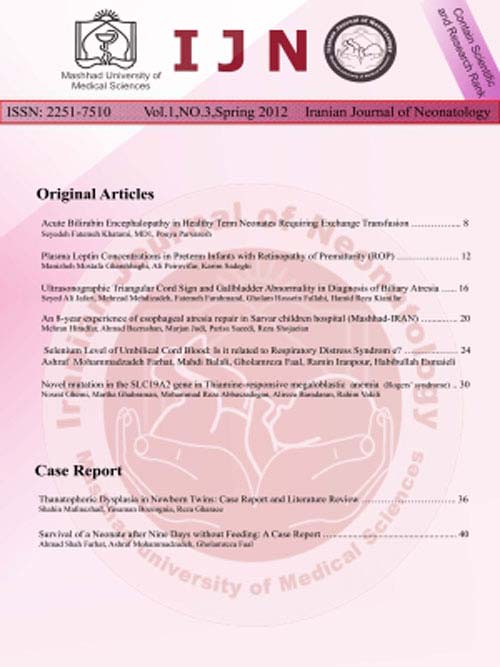Comparison of the Heated Humidified High-flow Nasal Cannula with Nasal Continuous Positive Airway Pressure as Primary Respiratory Support for Preterm Neonates: A Prospective Observational Study
Author(s):
Article Type:
Research/Original Article (دارای رتبه معتبر)
Abstract:
Background
Heated humidified high-flow nasal cannula (HHHFNC) is gaining popularity in the management of respiratory distress in preterm neonates. However, it is not known whether it takes precedence over the gold standard nasal continuous positive airway pressure (NCPAP) in this age group as a primary mode of non-invasive ventilation (NIV). There is limited evidence addressing this issue in the literature. Therefore, this study aimed to focus on the effect of HHHFNC on preterm neonates with respiratory distress, compared to NCPAP as a primary mode of respiratory support.Methods
A prospective observational study conducted in tertiary level III NICU. The preterm neonates 28-36 weeks with respiratory distress syndrome (onset of distress within ≤4 hours of life with FiO2 ≥0.25 with compatible chest radiograph) were managed with either HHHFNC or nCPAP The need for invasive ventilation within 72 hours of initiation of non-invasive respiratory support was studied. FiO2 and Downe’s scores were recorded every 4th hour for the first 48 hours.Results
In total, 84 neonates were enrolled in this study. Treatment failure for HHHFNC group was 34.4%, whereas it was 32.2% (P=0.34) for NCPAP group which indicated no significant differences. In the late preterm strata, NCPAP group obtained longer duration for NIV (Median: 64 vs 43 hours, respectively; P<0.001); however, there were no differences between the study groups regarding the use of supplemental oxygen. The estimation of the survival time was plotted using the Kaplan-Meier curve (P<0.001). In addition, the two groups were compared through Gehan–Breslow–Wilcoxon test. Moreover, the results revealed differences between the two groups in terms of the hazards ratio for time to success regarding such items as the intervention group, gestational age, birth weight, surfactant therapy, and Downe’s score (1.17; CI: 95% [0.7, 1.8]).Conclusion
Early HHHFNC obtained similar results, compared to NCPAP as a primary mode of NIV for a preterm population with respiratory distress, and it may not be superior to NCPAP.Keywords:
Language:
English
Published:
Iranian Journal of Neonatology, Volume:10 Issue: 3, Summer 2019
Pages:
51 to 57
magiran.com/p2022737
دانلود و مطالعه متن این مقاله با یکی از روشهای زیر امکان پذیر است:
اشتراک شخصی
با عضویت و پرداخت آنلاین حق اشتراک یکساله به مبلغ 1,390,000ريال میتوانید 70 عنوان مطلب دانلود کنید!
اشتراک سازمانی
به کتابخانه دانشگاه یا محل کار خود پیشنهاد کنید تا اشتراک سازمانی این پایگاه را برای دسترسی نامحدود همه کاربران به متن مطالب تهیه نمایند!
توجه!
- حق عضویت دریافتی صرف حمایت از نشریات عضو و نگهداری، تکمیل و توسعه مگیران میشود.
- پرداخت حق اشتراک و دانلود مقالات اجازه بازنشر آن در سایر رسانههای چاپی و دیجیتال را به کاربر نمیدهد.
In order to view content subscription is required
Personal subscription
Subscribe magiran.com for 70 € euros via PayPal and download 70 articles during a year.
Organization subscription
Please contact us to subscribe your university or library for unlimited access!


